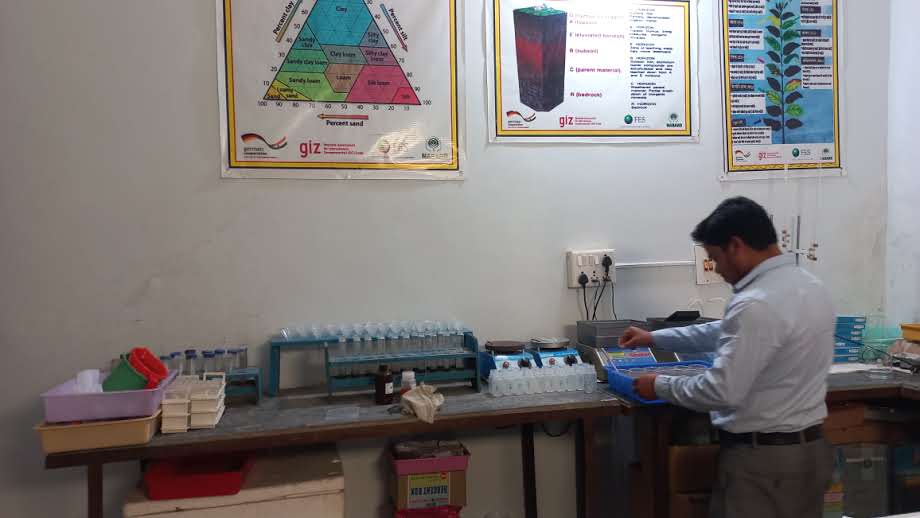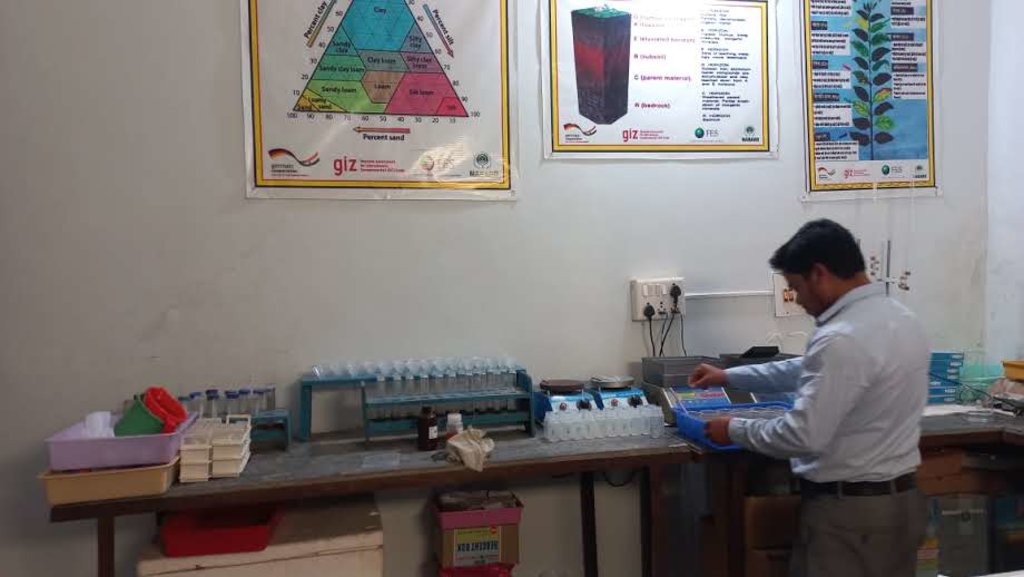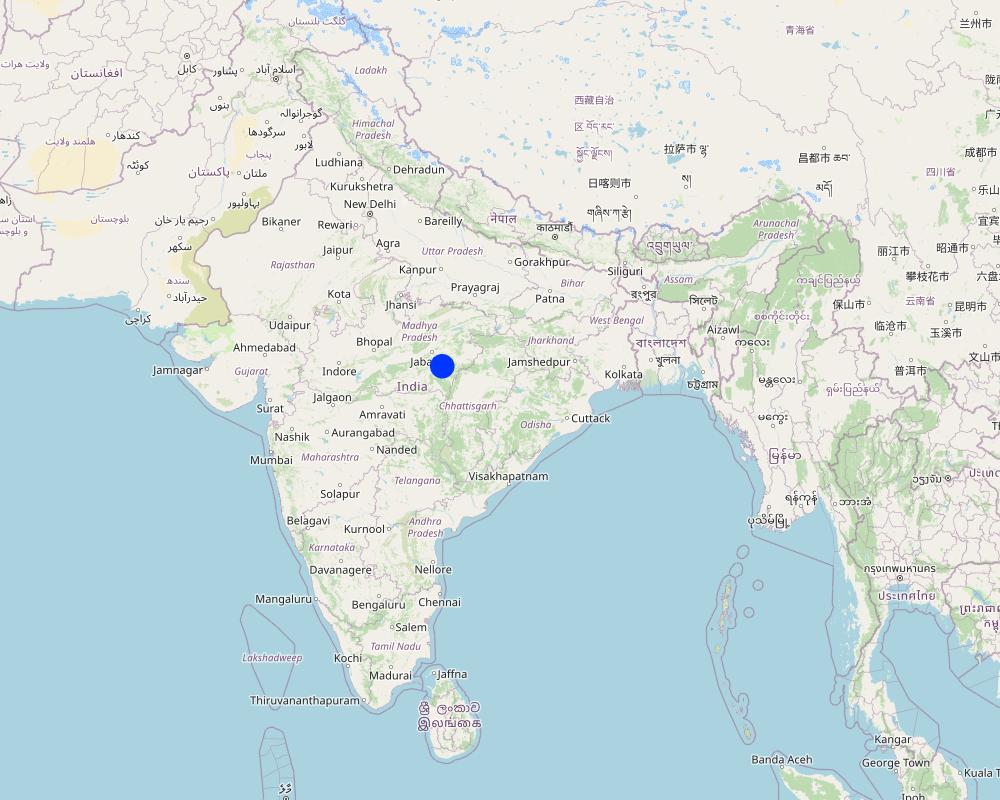Dissemination of Soil Test Results to Farmers through a Participatory Approach [ប្រទេសឥណ្ឌា]
- ការបង្កើត៖
- បច្ចុប្បន្នភាព
- អ្នកចងក្រង៖ Santosh Gupta
- អ្នកកែសម្រួល៖ Noel Templer, Stephanie Katsir, Tabitha Nekesa, Ahmadou Gaye, Siagbé Golli
- អ្នកត្រួតពិនិត្យច្រើនទៀត៖ Udo Höggel, Joana Eichenberger, Sally Bunning
Mitti ki namuna
approaches_6698 - ប្រទេសឥណ្ឌា
- សង្ខេបជា PDF
- សេចក្តីសង្ខេបពេញលេញជាទម្រង់ PDF សម្រាប់បោះពុម្ព
- សេចក្តីសង្ខេបពេញលេញទម្រង់អ៊ីនធឺនេត
- សេចក្តីសង្ខេបពេញលេញ (មិនមានទម្រង់ជាក់លាក់)
- Dissemination of Soil Test Results to Farmers through a Participatory Approach: 18 ខែ មិថុនា ឆ្នាំ 2023 (inactive)
- Dissemination of Soil Test Results to Farmers through a Participatory Approach: 14 ខែ កញ្ញា ឆ្នាំ 2023 (inactive)
- Dissemination of Soil Test Results to Farmers through a Participatory Approach: 11 ខែ មេសា ឆ្នាំ 2024 (public)
ពិនិត្យមើលគ្រប់ផ្នែក
ពង្រីកមើលទាំងអស់ បង្រួមទាំងអស់1. ព័ត៌មានទូទៅ
1.2 ព័ត៌មានលម្អិតពីបុគ្គលសំខាន់ៗ និងស្ថាប័នដែលចូលរួមក្នុងការវាយតម្លៃ និងចងក្រងឯកសារនៃវិធីសាស្ត្រផ្សព្វផ្សាយ
ឈ្មោះគម្រោងដែលបានចងក្រងឯកសារ/ វាយតម្លៃលើវិធីសាស្ត្រផ្សព្វផ្សាយ (បើទាក់ទង)
Soil protection and rehabilitation for food security (ProSo(i)l)ឈ្មោះអង្គភាពមួយ (ច្រើន) ដែលបានចងក្រងឯកសារ/ វាយតម្លៃលើវិធីសាស្ត្រផ្សព្វផ្សាយ (បើទាក់ទង)
Deutsche Gesellschaft für Internationale Zusammenarbeit (GIZ)ឈ្មោះអង្គភាពមួយ (ច្រើន) ដែលបានចងក្រងឯកសារ/ វាយតម្លៃលើវិធីសាស្ត្រផ្សព្វផ្សាយ (បើទាក់ទង)
Alliance Bioversity and International Center for Tropical Agriculture (Alliance Bioversity-CIAT) - ប្រទេសកេនយ៉ាឈ្មោះអង្គភាពមួយ (ច្រើន) ដែលបានចងក្រងឯកសារ/ វាយតម្លៃលើវិធីសាស្ត្រផ្សព្វផ្សាយ (បើទាក់ទង)
Ecociate Consultants (Ecociate Consultants) - ប្រទេសឥណ្ឌា1.3 លក្ខខណ្ឌទាក់ទងទៅនឹងការប្រើប្រាស់ទិន្នន័យដែលបានចងក្រងតាមរយៈវ៉ូខេត
តើពេលណាដែលទិន្នន័យបានចងក្រង (នៅទីវាល)?
22/02/2023
អ្នកចងក្រង និង(បុគ្គលសំខាន់ៗ)យល់ព្រមទទួលយកនូវលក្ខខណ្ឌនានាទាក់ទងទៅនឹងការប្រើប្រាស់ទិន្នន័យដែលបានចងក្រងតាមរយៈ វ៉ូខេត:
បាទ/ចា៎
2. ការពណ៌នាអំពីវិធីសាស្ត្រផ្សព្វផ្សាយ SLM
2.1 ពណ៌នាសង្ខេបខ្លីពីវិធីសាស្ត្រផ្សព្វផ្សាយ
A systematic approach has been developed under the project for collecting soil samples, conducting the soil test results, issuing soil health cards, building the capacity of farmers to interpret the soil health card and apply the required nutrients to the soil based on the soil test result
2.2 ពណ៌នាលម្អិតពិវិធីសាស្ត្រផ្សព្វផ្សាយ
ពណ៌នាលម្អិតពិវិធីសាស្ត្រផ្សព្វផ្សាយ:
Soil testing is a pre-cultivation activity that gives a good idea about soil structure and mineral composition ratios. The essential nutrients required for various crop growths can be estimated during soil testing. The Foundation for Ecological Security (FES) has established a state-of-the-art soil testing laboratory for testing soil samples in India's Mandla District of Madhya Pradesh. The soil test lab was established in 2016 with a capacity to test 1500-2000 soil samples every year. Based on a soil sampling process, it takes around 2 days to generate the soil test results for 20 soil samples. Collected soil samples are tested for 12 parameters. These parameters include Soil Ph, Soil organic carbon (SoC), electrical conductivity (EC), major nutrients like nitrogen(N), phosphorus (P), potassium (K), secondary nutrients like sulphur, magnesium, iron, boron, zinc, manganese, and copper. Based on the soil test report, farmers are issued a soil health card with crop-specific recommendations for additional chemical and organic inputs into the soil.
To ensure the accuracy of the sampling process and proper dissemination of generated results among the farmers, FES has developed a very systematic process which consists of:
•the collection of soil samples
•the analysis of collected soil samples in an FES lab
•the issuance of soil health cards
•the interpretation of soil test results
•noticing of test results to farmers
•farmers are able to implement practices, recommended by the test result
The entire process, from soil sampling to dissemination, is briefly mentioned below:
•Developing the grids for a random collection of soil samples: The first step is to develop a geographical grid for collecting random samples based on predefined parameters. In the irrigated areas, samples are drawn in a grid of 2.5 ha, while in rainfed areas, samples are drawn from a grid of 10 ha. While developing the grid, farmers' fields are categorized into the following parameters. Each of the parameters is assigned a specific score, and based on the obtained score, each farmer’s land is given a specific number for easy identification on soil maps. These include the a) type of soil, b) type of field, e.g., upland, medium land, or low land, c) crop cycle (Single crop, multiple crops) d) The slope of the field. This entire exercise is a soil survey exercise used to develop soil maps for each geographical unit village, block, district.
•Collection of soil samples: From each classified grid, soil samples are collected from 5 different locations between the harvest of one crop and the sowing/planting of another crop when fields are vacant. The soil samples are collected at a depth of 5 to 15 cm. All the collected soil samples are mixed repeatedly, and a portion of the collected soil is kept aside each time. The mixing process is followed 5-6 times to ensure collected soil samples represent the entire area. Finally, around 500 gm of soil is packed in plastic polythene based on the above grid parameters.
•Soil sample analysis: Collected soil samples are transported to the centralized soil test lab in Mandla (MP) for testing and analysis. The samples are analyzed by qualified lab personnel. The analysis process for the above mentioned 12 parameters takes around 2 days (considering 8-9 working hours in a day).
•Issuance of soil health card: Based on the results obtained from the analysis, soil health cards are issued to farmers. The soil health card contains the following information in the local language (Hindi) so that farmers understand the test results and their implications:
a.Basic details of the farmer: name, address, soil grid, GPS coordinates, field identification number, etc.
b.Soil test results for above mentioned 12 parameters: results of the soil test in their respective units, standard numbers, grading of the obtained result (acidic/saline for PH., high, medium, low for other parameters)
c.Crop-wise soil correction recommendations for major crops: recommendations for synthetic fertilizers, biofertilizers, and compost
d.Pre-printed information with photos for identification of nutrient deficiency in the crops.
•Dissemination of soil health card to farmers: To ensure that farmers understand the results and implement the practices at their field, local community resource persons reach out to every farmer to make them understand the soil test results and closely monitor their farmers’ practices across the crop stages. Farmers are also encouraged to maintain farm diaries for their practices. They are also trained in the preparation of various bio-inputs and compost for application in their field.
2.3 រូបភាពនៃវិធីសាស្ត្រផ្សព្វផ្សាយ
កំណត់សំគាល់ទូទៅរបស់រូបថត:
All the photos have been taken at the soil test lab of the FES.
2.5 ប្រទេស/តំបន់/ទីតាំងកន្លែង ដែលវិធីសាស្ត្រផ្សព្វផ្សាយត្រូវបានអនុវត្តន៍
ប្រទេស:
ប្រទេសឥណ្ឌា
តំបន់/រដ្ឋ/ខេត្ត:
Madhya Pradesh
បញ្ជាក់បន្ថែមពីលក្ខណៈនៃទីតាំង:
Mandla
មតិយោបល់:
Mandla, Madhya Pradesh, India
Map
×2.6 កាលបរិច្ឆេទនៃការចាប់ផ្តើម និងបញ្ចប់នៃវិធីសាស្រ្តផ្សព្វផ្សាយនេះ
សូមបញ្ជាក់ឆ្នាំដែលបានបង្កើតឡើង:
2018
2.7 ប្រភេទនៃវិធីសាស្ត្រផ្សព្វផ្សាយ
- ផ្អែកលើគម្រោង/កម្មវិធី
2.8 គោលបំណង/ទិសដៅសំខាន់នៃវិធីសាស្ត្រផ្សព្វផ្សាយ
1. Ensure judicious usage of fertilizers and micronutrients based on the requirement of the soil
2. Ensure quality soil testing and dissemination of results
3. Build farmers' capacity for interpretation of soil health cards
4. Develop soil maps based on the in-house results from the soil test lab
2.9 លក្ខខណ្ឌអនុញ្ញាត ឬរារាំងការអនុវត្តន៍បច្ចេកទេសដែលស្ថិតនៅក្រោមវិធីសាស្រ្តផ្សព្វផ្សាយ
បរិបទនៃស្ថាប័ន
- អំណោយផល
The entire dissemination methodology is done through community-based organizations
ការសហការ/ការសម្របសម្រួលតួអង្គពាក់ព័ន្ធ
- អំណោយផល
Several stakeholders, such as FES, farmers, equipment suppliers, the scientific community, and soil scientists, are involved in the project
គោលនយោបាយ
- អំណោយផល
Soil test results are an excellent input for the agricultural policies around fertilizers, farming practices, and soil health-related policies
អភិបាលកិច្ចដី (ការសម្រេចចិត្ត ការអនុវត្ត និងការរឹតបន្តឹង)
- អំណោយផល
A soil health card is an excellent tool for farmers to decide on the usage of fertilizers and the kind of farming practices to implement
ចំណេះដឹងស្តីពី SLM និងការទទួលបានការគាំទ្រផ្នែកបច្ចេកទេស
- អំណោយផល
Soil health cards inform the farmers and the project management team so to decide on required interventions and farming practices
ទីផ្សារ (ទិញធាតុចូល លក់ផលិតផល) និងតម្លៃ
- អំណោយផល
Very much relevant as soil test results quantify the number of farm inputs to be applied to the farm
3. ការចូលរួម និងតួនាទីរបស់ភាគីពាក់ព័ន្ធ
3.1 អ្នកពាក់ព័ន្ធដែលបានចូលរួមក្នុងវិធីសាស្ត្រផ្សព្វផ្សាយ និងតួនាទីរបស់ពួកគេ
- អ្នកប្រើប្រាស់ដីក្នុងតំបន់/សហគមន៍
Farmers from the project area
Soil samples were collected from the field of farmers. They have actively participated in the projects for managing the soil samples, participating in the capacity building programs, and implementing the recommended practices.
- អង្គការសហគមន៍មូលដ្ឋាន
FES, the implementing NGO, have formed the Villages Environment Committee (VEC) in their project villages as community-based organizations
VECs facilitated the implanting of a project by mobilizing the communities as and when needed. FES reached farmers through the VECs, to collect the soil samples or disseminate the information. VECs also facilitated community-level implementation activities.
- អ្នកឯកទេសគ្រប់គ្រងដីប្រកបដោយចីរភាព/ទីប្រឹក្សាបច្ចេកទេសកសិកម្ម
SLM Specialist
Documentation of the activities
- អង្គការក្រៅរដ្ឋាភិបាល
Foundation for Ecological Security (FES) is a well-known NGO registered in India. It focuses on ecology-related issues and works closely with farmers and forest-based communities.
FES played an essential role in the project. Primary activities were as follows:
1. Establishment of soil testing laboratory and hiring the technical team to conduct the soil test lab
2. Collection of soil test samples and building the capacity of farmers on soil sample collection
3. Conducting soil test results and issuance of soil health cards to farmers
4. Developing a soil health map for the project areas
5. Capacity building of farmers for the interpretation of soil health cards and ensuring the implementation of recommended practices
- អង្គការអន្តរជាតិ
GIZ, India
Funding of the project
ប្រសិនមានភាគីពាក់ព័ន្ធច្រើនចូលរួមសូមចង្អុលបង្ហាញភ្នាក់ងារដែលនាំមុខគេ:
Foundation for Ecological Security
3.2 ការចូលរួមរបស់អ្នកប្រើប្រាស់ដីក្នុងតំបន់/ សហគមន៍ក្នុងតំបន់ក្នុងដំណាក់កាលផ្សេងគ្នានៃវិធីសាស្រ្តផ្សព្វផ្សាយ
| ការចូលរួមរបស់អ្នកប្រើប្រាស់ដីក្នុងតំបន់/សហគមន៍ក្នុងតំបន់ | សូមបញ្ជាក់នរណាត្រូវបានចូលរួម ព្រមទាំងពណ៌នាសកម្មភាពទាំងនោះ | |
|---|---|---|
| ការចាប់ផ្តើម/ការលើកទឹកចិត្ត | អសកម្ម | The FES led the initiation of discussions with its donor organizations. Discussions with communities to understand the challenges and opportunities. |
| ការរៀបចំផែនការ | អន្តរកម្ម | Local community institutions played a significant role in the entire process of planning and execution |
| ការអនុវត្តន៍ | អន្តរកម្ម | Farmers and community-based institutions were actively involved in implementing multiple activities under the project, such as collecting soil samples, supplying them to the soil test labs, and Implementing the recommended practices. |
| ការត្រួតពិនិត្យ និងវាយតម្លៃ | អន្តរកម្ម | Community-based institutions played an important role in monitoring individual farmers for implementing the recommendations provided to farmers. They also monitored the results regarding crop progress, crop productivity, and improvement in soil health status. |
3.4 ការសម្រេចចិត្តលើការជ្រើសរើសបច្ចេកទេស SLM
សូមបញ្ជាក់តើអ្នកណាជាអ្នកបានសម្រេចចិត្តក្នុងការជ្រើសរើសបច្ចេកទេសដើម្បីយកមកអនុវត្តន៍:
- គ្រប់ភាគីពាក់ព័ន្ធទាំងអស់ដែលជាផ្នែកនៃវិធីសាស្រ្តផ្សព្វផ្សាយដោយមានការចូលរួម
ចូរពន្យល់:
All actors, including the farmers, CBO, NGO, and soil scientists, mutually discussed and decided on the implementation of technology as all stakeholders were equally crucial for the effective and result-oriented implementation of the technology.
សូមបញ្ជាក់ តើការសម្រេចធ្វើឡើងដោយផ្អែកលើអ្វីជាមូលដ្ឋាន:
- វាយតម្លៃទៅលើចំណេះដឹងស្តីអំពី SLM ដែលបានចងក្រងជាឯកសារបានត្រឹមត្រូវ (ផ្អែកលើភស្តុតាងជាមូលដ្ឋានដើម្បីសម្រេចចិត្ត)
- លទ្ធផលបានពីការស្រាវជ្រាវ
4. ជំនួយបច្ចេកទេស ការកសាងសមត្ថភាព និងការគ្រប់គ្រងចំណេះដឹង
4.1 ការកសាងសមត្ថភាព/ បណ្តុះបណ្តាល
តើវគ្គបណ្តុះបណ្តាលបានផ្តល់ឱ្យអ្នកប្រើប្រាស់ដី/អ្នកពាក់ព័ន្ធផ្សេងៗទៀតដែរឬទេ?
បាទ/ចា៎
សូមបញ្ជាក់តើអ្នកណាត្រូវបានបណ្តុះបណ្តាល:
- អ្នកប្រើប្រាស់ដី
- បុគ្គលិកចុះទីវាល/អ្នកផ្តល់ប្រឹក្សាយោបល់
ប្រសិនទាក់ទង សូមបញ្ជាក់ ភេទ អាយុ ស្ថានភាពគ្រួសារ ជនជាតិដើមភាគតិច។ល។:
Both male and female farmers in all age groups were trained under the project. The majority of the farmers were from tribal communities.
ទម្រង់នៃការបណ្តុះបណ្តាល:
- ពីកសិករទីកសិករ
- ទីតាំងបង្ហាញ
- ការប្រជុំជាសាធារណៈ
ប្រធានបទបណ្តុះបណ្តាល:
1. Importance of soil testing for the judicious use of fertilizers
2. Methods for soil sample collection
3. Interpretation of soil health card
4. Dissemination of soil test results and ways and means for implementing the recommended practices following organic and non-organic implementation practices
4.2 សេវាផ្តល់ប្រឹក្សាយោបល់
តើអ្នកប្រើប្រាស់ដីបានទទួលនូវសេវាផ្តល់ប្រឹក្សាដែរ ឬទេ?
បាទ/ចា៎
សូមបញ្ជាក់ប្រសិនបើសេវាកម្មប្រឹក្សាយោបល់ត្រូវបានផ្តល់ឱ្យ:
- នៅលើដីរបស់អ្នកប្រើប្រាស់ដី
ពណ៌នា/ពន្យល់:
FES has a team of community-based resource persons from the local community and villages to provide advisory services to farmers
4.3 ការពង្រឹងសមត្ថភាពស្ថាប័ន (ការអភិរឌ្ឍន៍អង្គភាព)
តើស្ថាប័នទាំងអស់ត្រូវបានបង្កើតឡើង ឬពង្រឹងសមត្ថភាពតាមរយៈវិធីសាស្ត្រផ្សព្វផ្សាយដែរ ឬទេ?
- បាទ/ច៎ា បានខ្លាំង
សូមបញ្ជាក់ថាតើស្ថាប័នត្រូវបានពង្រឹង ឬបង្កើតឡើងនៅត្រឹមកម្រិតណា(ច្រើន)?
- ថ្នាក់មូលដ្ឋាន
ចូពណ៌នាពីស្ថាប័ន តួនាទី និងទំនួលខុសត្រូវ សមាជិក ។ល។:
Village-level environment committees were formed to discuss the issues related to environmental concerns, livelihoods, and other social problems at the village level. These committees consist of male and female members representing the entire village.
សូមបញ្ជាក់ប្រភេទនៃការគាំទ្រ:
- ហិរញ្ញវត្ថុ
- ការកសាងសមត្ថភាព/ បណ្តុះបណ្តាល
សូមផ្តល់ព័ត៌មានបន្ថែមទៀតឱ្យបានលម្អិត:
These committees were provided financial support to implement the identified activities based on the provision under the project and proposals submitted by the local committees. FES regularly provides training and handholding support to these committees.
4.4 ការត្រួតពិនិត្យ និងវាយតម្លៃ
តើការត្រួតពិនិត្យ និងវាយតម្លៃគឺជាផ្នែកមួយនៃវិធីសាស្ត្រដែរឬទេ?
បាទ/ចា៎
មតិយោបល់:
The soil health report card is very useful in monitoring of the status of soil health and measuring the impact of various practices and intervention
ប្រសិន បាទ/ច៎ា តើឯកសារនេះបានបង្កើតឡើងក្នុងគោលបំណងប្រើប្រាស់សម្រាប់ការត្រួតពិនិត្យ និងវាយតម្លៃដែរឬទេ?
ទេ
4.5 ការស្រាវជ្រាវ
តើការស្រាវជ្រាវ គឺជាផ្នែកមួយនៃវិធីសាស្រ្តដែរឬទេ?
បាទ/ចា៎
បញ្ជាក់ប្រធានបទ:
- បរិស្ថានវិទ្យា
- បច្ចេកវិទ្យា
5. ថវិកា និងសម្ភារៈឧបត្ថម្ភពីខាងក្រៅ
5.1 ថវិកាប្រចាំឆ្នាំសម្រាប់ផ្សព្វផ្សាយ SLM
ប្រសិនបើចំនួនពិតប្រាកដនៃថវិកាប្រចាំឆ្នាំមិនត្រូវបានដឹងច្បាស់ សូមប្រាប់ពីចន្លោះនៃថវិកានោះ:
- 2,000-10,000
មតិយោបល់ (ឧ. ប្រភពសំខាន់នៃមូលនិធិ/ម្ចាស់ជំនួយចំបង):
Externally funded projects (GIZ)
5.2 ការគាំទ្រផ្នែកហិរញ្ញវត្ថុ / សម្ភារៈដែលបានផ្តល់ទៅឱ្យអ្នកប្រើប្រាស់ដី
តើអ្នកប្រើប្រាស់ដីបានទទួលការគាំទ្រផ្នែកហិរញ្ញវត្ថ/សម្ភារៈសម្រាប់ការអនុវត្តន៍បច្ចេកទេសដែរឬទេ:
ទេ
5.3 សូមបញ្ជាក់ពីធាតុចូលត្រូវបានផ្តល់បដិភាគ (រួមទាំងកម្លាំងពលកម្ម)
- សម្ភារៈ
| សូមបញ្ជាក់ ធាតុចូលណាខ្លះដែលបានផ្តល់បដិភាគ | កម្រិតទំហំប៉ុណ្ណា | សូមបញ្ជាក់ពីការបដិភាគ |
|---|---|---|
| ម៉ាស៊ីន | ផ្តល់ហិរញ្ញវត្ថុមួយផ្នែក | Different equipment used for testing the soils |
| ឧបករណ៍ | ផ្តល់ហិរញ្ញវត្ថុមួយផ្នែក | Different tools are used for collecting soil samples and for soil testing |
ប្រសិនបើកម្លាំងពលកម្មធ្វើដោយអ្នកប្រើប្រាស់ដី តើវាជាធាតុចូលដ៏សំខាន់មួយដែរ ឬទេ:
- ដោយស្ម័គ្រចិត្ត
5.4 ឥណទាន
តើឥណទានដែលបានផ្តល់នៅក្រោមវិធីសាស្ត្រផ្សព្វផ្សាយសម្រាប់សកម្មភាព SLM នេះយ៉ាងដូចម្តេច?
ទេ
5.5 ការលើកទឹកចិត្ត ឬវិធីសាស្ត្រដ៏ទៃទៀត
តើមានការលើកទឹកចិត្តផ្សេងទៀត ឬឧបករណ៍ប្រើប្រាស់ដើម្បីលើកកម្ពស់ការអនុវត្តន៍បច្ចេកទេស SLM?
ទេ
6. ការវិភាគរកផលប៉ះពាល់ និងសេចក្តីសន្និដ្ឋាន
6.1 ផលប៉ះពាល់នៃវិធីសាស្ត្រផ្សព្វផ្សាយ
តើវិធីសាស្រ្តផ្សព្វផ្សាយនេះអនុញ្ញាតឱ្យធ្វើការសម្រេចចិត្ដដោយផ្អែកលើភស្តុតាងជាមូលដ្ឋានដែរ ឬទេ?
- ទេ
- បាទ/ច៎ា បន្តិចបន្តួច
- បាទ/ច៎ា ជាមធ្យម
- បាទ/ច៎ា បានខ្លាំង
Soil health card-based changes in soil management and developing the evidence for soil health monitoring
តើវិធីសាស្រ្តផ្សព្វផ្សាយនេះធ្វើឱ្យប្រសើរឡើងនូវការសម្របសម្រួលនិងការអនុវត្តចំណាយរបស់ SLMមានប្រសិទ្ធិភាពបែបណា? :
- ទេ
- បាទ/ច៎ា បន្តិចបន្តួច
- បាទ/ច៎ា ជាមធ្យម
- បាទ/ច៎ា បានខ្លាំង
Reduced the cost of applying fertilizers and other inputs through a result-based application
តើវិធីសាស្ត្រផ្សព្វផ្សាយនេះធ្វើឱ្យចំណេះដឹងប្រសើឡើង និងសមត្ថភាពរបស់អ្នកប្រើប្រាស់ដីក្នុងការអនុវត្តន៏ SLM?
- ទេ
- បាទ/ច៎ា បន្តិចបន្តួច
- បាទ/ច៎ា ជាមធ្យម
- បាទ/ច៎ា បានខ្លាំង
Training and handholding by the team of implementing partners have helped land users to interpret the result of soil health card, collection of soil samples and following the recommended practices
តើវីធីសាស្ត្រផ្សព្វផ្សាយនេះពង្រឹងចំណេះដឹង និងកសាងសមត្ថភាពរបស់អ្នកពាក់ព័ន្ធឬទេ?
- ទេ
- បាទ/ច៎ា បន្តិចបន្តួច
- បាទ/ច៎ា ជាមធ្យម
- បាទ/ច៎ា បានខ្លាំង
Other stakeholders such as implementing team got information about the outcome of their practices. More importantly, the soil health card was helpful in providing precise information on the application of fertilisers and bio-inputs.
តើវិធីសាស្ត្រផ្សព្វផ្សាយបានលើកទឹកចិត្តដល់អ្នកប្រើប្រាស់ដីដែលជាយុវជន/ក្មេងជំនាន់ក្រោយឱ្យចូលរួមក្នុង SLM ?
- ទេ
- បាទ/ច៎ា បន្តិចបន្តួច
- បាទ/ច៎ា ជាមធ្យម
- បាទ/ច៎ា បានខ្លាំង
Youths were greatly involved in collection of soil samples
6.2 ការលើកទឹកចិត្តចម្បងៗរបស់អ្នកប្រើប្រាស់ដីសម្រាប់ការអនុវត្តបច្ចេកទេស SLM
- បង្កើនប្រាក់ចំណេញ (សមត្ថភាព) បង្កើនអត្រាចំណេញ
With soil test results, land users now need to apply only the required nutrients in a specific quantity. This reduced the cost of soil management and fertilisers.
- ការកាត់បន្ថយការធ្លាក់ចុះគុណភាពដី
Soil test results were helpful in preventing and reducing the non-judicious usage of synthetic fertilisers, which was among the major reasons for land degradation in the project area. Also recommendations for both organic and synthetic fertilisers based on the soil health cards helped farmers in replacing synthetic fertilisers with organic fertilisers.
- ពង្រឹងស្មារតីផ្នែកបរិស្ថាន
6.3 សកម្មភាពផ្សព្វផ្សាយដែលប្រកបដោយចីរភាព
តើអ្នកប្រើប្រាស់ដីអាចធ្វើឱ្យមានចីរភាពនូវអ្វីដែលត្រូវបានអនុវត្តន៍តាមរយៈវិធីសាស្ត្រផ្សព្វផ្សាយដែរឬទេ(ដោយពុំមានការគាំទ្រពីអ្នកខាងក្រៅ)?
- បាទ/ចា៎
ប្រសិនបាទ/ច៎ា សូមរៀបរាប់ថាធ្វើយ៉ាងម៉េច:
Yes. The benefit in both reduced cost and improved soil health are the triggers to sustaining the practices. Also, the involvement of local community institutions will also ensure the sustainability of interventions.
6.4 ភាពខ្លាំង/ គុណសម្បត្តិនៃវិធីសាស្ត្រផ្សព្វផ្សាយ
| ភាពខ្លាំង/ គុណសម្បត្តិ/ ឱកាស ទស្សនៈរបស់អ្នកប្រើប្រាស់ដី |
|---|
| Judicious use of fertilizers and pesticides based on the nutrient requirement of soil, as mentioned under the soil health report |
| Separate recommendations for both chemical and organic (bio-inputs) are a good way for land users to make informed decisions |
| Tracing the improvement in soil health status based on the land users' agricultural practices |
| ភាពខ្លាំង/ គុណសម្បត្តិ/ ឱកាស ទស្សនៈរបស់បុគ្គលសំខាន់ៗ |
|---|
| Developing the soil maps for the entire area to design appropriate interventions for the project |
| Instead of general recommendations for input application, the soil health card helped develop farmer/village-centric extension services for the farmers |
| Understand the impact of various interventions through periodic soil testing to document what has worked and what has not. Even this evidence can be used to monitor the soil organic carbon content for designing carbon-based projects and/or to access national or international carbon reduction credits. |
6.5 ភាពខ្សោយ/ គុណវិបត្តិនៃវិធីសាស្ត្រ និងរកដំណោះស្រាយ
| ភាពខ្សោយ/ គុណវិបត្តិ/ ហានិភ័យ ទស្សនៈរបស់អ្នកប្រើប្រាស់ដី | តើបច្ចេកទេសទាំងនោះបានដោះស្រាយបញ្ហាដូចម្តេច? |
|---|---|
| Farmers are still unaware of the soil test facility and its benefits | Regular awareness programs along with a demonstration of soil sample collection |
| ភាពខ្សោយ/ គុណវិបត្តិ/ ហានិភ័យក្នុងទស្សនៈរបស់បុគ្គលសំខាន់ៗ | តើបច្ចេកទេសទាំងនោះបានដោះស្រាយបញ្ហាដូចម្តេច? |
|---|---|
| Farmers' strong belief in the application of a certain quantity of fertilizers to ensure better production | This requires specific behavior change campaigns through local demonstration and documentation |
| Government authorities also conduct the soil test and issue the soil health card. However the farmers' experience with such system has not been outstanding. | Put efforts into conveying the difference between both approaches by promptly issuing the soil health card |
| The soil test lab is in the District capital, so farmers in far-away areas may face difficulties in accessing the facility | Explore the option of establishing soil test labs near farmers' locations |
7. ឯកសារយោង និងវេបសាយ
7.1 វិធីសាស្ត្រ/ ប្រភពនៃព័ត៌មាន
- តាមការចុះទីវាល ការស្រាវជ្រាវនៅទីវាល
1
- ការសម្ភាសន៍ជាមួយអ្នកប្រើប្រាស់ដី
5
- ការសម្ភាសន៍ជាមួយអ្នកជំនាញ/ ឯកទេស
2
- ការចងក្រងពីរបាកការណ៍ និងឯកសារផ្សេងៗទៀតដែលមាន
3
7.3 ចូលទៅទាញយកឯកសារពាក់ព័ន្ធដែលមានលើបណ្តាញអ៊ិនធឺណែត
ចំណងជើង/ ពណ៌នា:
Operational Guidelines for implementation of CENTRALLY SPONSORED SCHEME SOIL HEALTH CARD
វេបសាយ:
https://agricoop.nic.in/sites/default/files/GSHC3.pdf
ការតភ្ជាប់ និងម៉ូឌុល
ពង្រីកមើលទាំងអស់ បង្រួមទាំងអស់ការតភ្ជាប់
គ្មានការតភ្ជាប់
ម៉ូឌុល
គ្មានម៉ូឌុល







